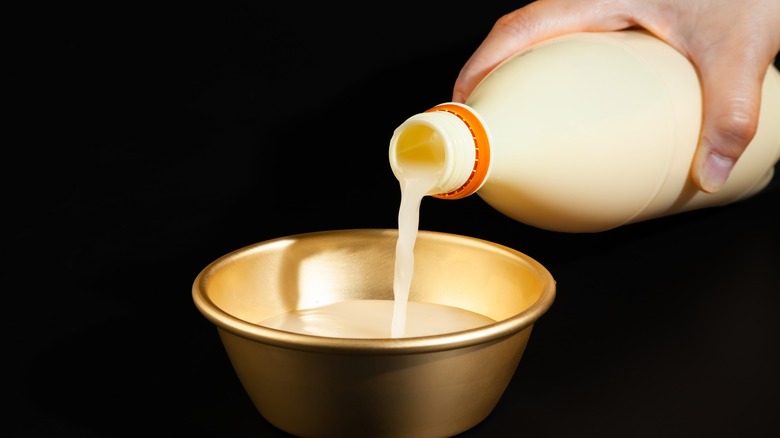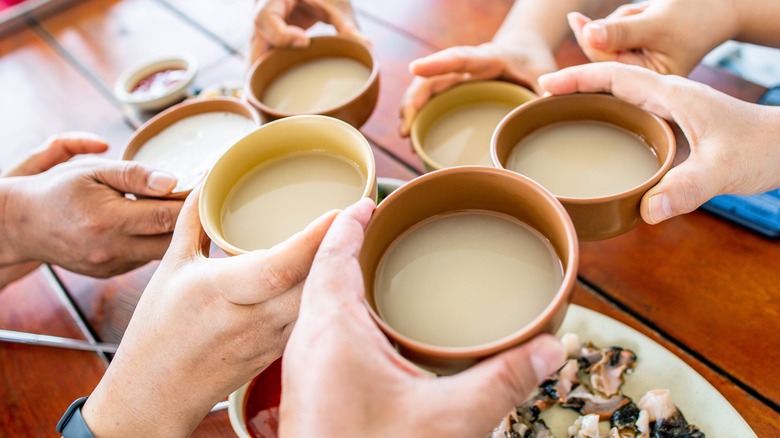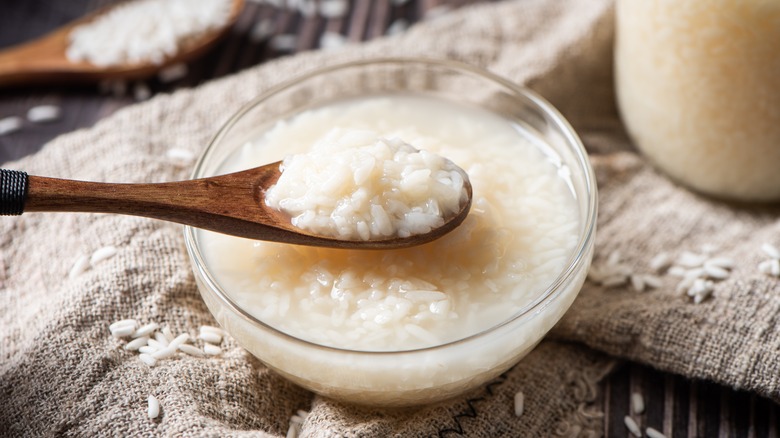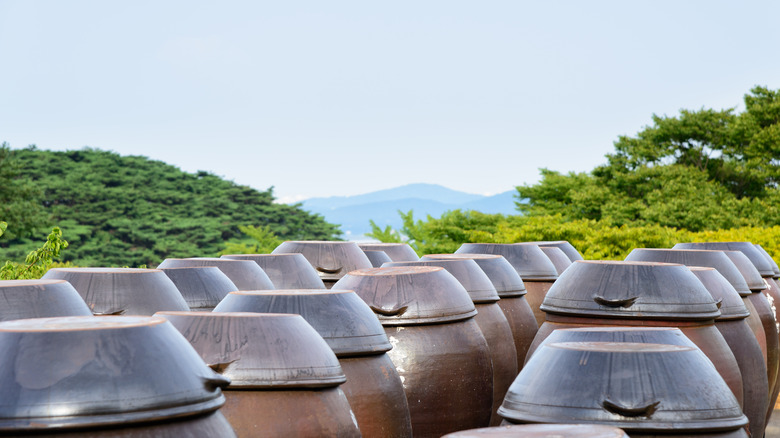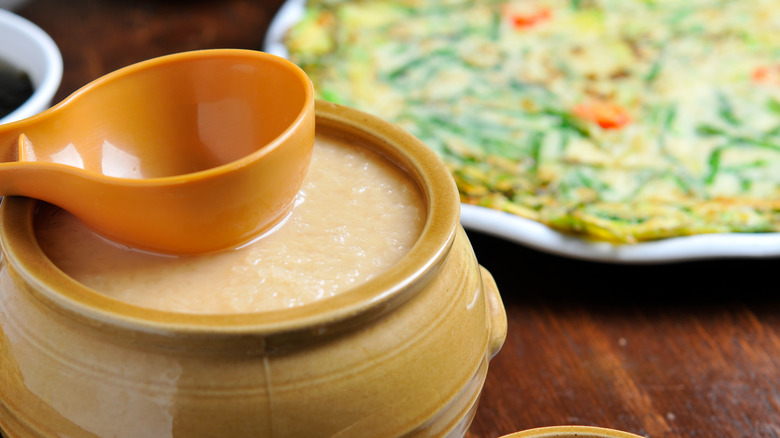The Oldest Alcoholic Drink In Korea Predates Soju By Centuries
Soju may be the most internationally famous alcoholic Korean beverage, but it is not the oldest in the Land of Morning Calm. With a white, cloudy appearance, makgeolli dates back to the Goyreo Dynasty (918-1392), while soju was first made in Korea during the 1300s. For centuries makgeolli was viewed as the alcohol of the commoner because clear alcohol was reserved as an offering to ancestors or for the upper class, but in modern times makgeolli is available for everyone and is enjoyed with meals or snack foods.
Made primarily with fermented rice, makgeolli generally is about 6% to 8% alcohol. The process of making makgeolli is simple enough that Korean families would often make it at home to be consumed daily, as well as for special occasions. However, there are plenty of commercial makgeolli operations, with some exporting to the United States, where it is seeing an increase in popularity and is being carried by more bars and grocery stores.
A drink for farmers
For a long time makgeolli was associated with farmers and laborers because it was cheap and viewed as nutritional. A bottle of makgeolli contains protein, carbohydrates, dietary fiber, vitamins B and C, lactobacilli and yeast. Because it is unfiltered, makgeolli also contains lactic acid.Due to its popularity among farmers, makgeolli was even called nongju, meaning farmer's wine. Makgeolli also appealed to farmers and laborers because of its carbonation, which is considered refreshing. For those reasons, a glass of makgeolli was generally enjoyed with a mid-morning snack or with lunch in order to power farmers and workers through the rest of the workday. For centuries, makgeolli enjoyed widespread popularity; however, during the Japanese occupation of Korea from 1910 to 1945, the Japanese government banned home brewing in 1934. Then in the 1960s, rice was not allowed to be converted into alcohol due to a grain shortage.
For these two reasons, the consumption of makgeolli greatly declined, as well as a change in alcoholic consumption. Following the 1988 Seoul Olympics, beer grew in popularity, pushing out makgeolli. However, in more recent times, Koreans have increased their consumption of the historically significant beverage for its health benefits, as an alternative to soju and beer, and for a sense of nostalgia.
How makgeolli is made
Also called takju or "cloudy alcohol" in Korean, makgeolli starts with rice to which a fermentation starer is added that is wheat-based. Barley, wheat, and corn are also frequently used to make makgeolli. While there are different processes that are followed to make makgeolli, a basic one calls for steamed rice to be blended with the fermentation starter (nuruk) and water and then kept in a container while the fermentation occurs. Generally, it takes only about 7 to 10 days for the rice mixture to transform into makgeolli. At this point, the liquid is strained in order to separate the alcohol from the solid residue. Often a mesh cloth is used to remove the solids, which leaves behind the liquor that is cloudy and white in appearance.
When making it at home, the maker can opt to dilute the fermented liquid with equal parts water. The temperature in which makgeolli is made is highly important. If it's too cold, then fermentation won't happen, and if it's too hot, then the mixture could become vinegar.
Makgeolli has a complex flavor
Like most foods and beverages, how makgeolli is made affects how it tastes. Some brands are sweeter than others and some have a thicker texture, both of which reflect the recipe and fermentation process. Makgeolli's flavor is derived from the wheat-based starter and what grains are used to make the beverage, as well as if sweeteners are incorporated. Additionally, the temperature at which makgeolli is fermented and for how long will change its flavor. Thanks to the fermentation process, makgeolli can even have a fizzy quality. Other words to describe makgeolli include bitter or sour tasting and with a fruity or floral aroma.
While some companies add aspartame or other sweeteners to makgeolli, increasingly producers are starting to make all natural versions of the beverage. The taste also differs from store-bought makgeolli compared to those made at home, which typically are not as sweet as the mass -produced bottles and are thicker, and thus, more filling. In addition to the traditional flavor of makgeolli, companies are now making makgeolli in more flavors, such as different kinds of fruit or ginseng.
How makgeolli is enjoyed
When drinking makgeolli, it should be chilled for the best flavor and served in small, shallow bowls. Sediment may settle at the bottom of the bottle of makgeolli, so it's best to gently turn the bottle upside down a few times to mix it. If the makgeolli is unpasteurized, there will also be pressure in the bottle. To release that pressure, open and close the cap repeatedly to let out some out the air before serving.
Makgeolli is most often consumed with food, such as savory pancakes made with kimchi, seafood and scallions, or mung bean. Other common foods for pairing include dubu kimchi (fresh tofu with kimchi) and jokbal (braised pig trotters). Once opened, pasteurized makgeolli can be kept for a few months before going bad. Unpasteurized makgeolli has a much shorter shelf life once opened because it will continue to ferment whether kept in the fridge or not. It's best to consume the opened bottle within a couple of days for the best taste.
For a more modern take on the centuries-old alcohol, it can be made into cocktails, such as one served at Jungsik in New York City that combines makgeolli, soju, lemon, and simple syrup with bokbunjaju (black raspberry wine). Other cocktails made with makgeolli included melon juice, honey, and flavored bitters.
